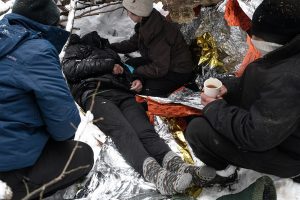Within a year of Russia’s invasion of Ukraine, Poland welcomed 1.5 million Ukrainian refugees and provided them with assistance, including work and residence permits. In contrast, along Poland’s northern border with Belarus, migrants and asylum seekers mainly from the Middle East and Africa face harsh policies to keep them out.
Since November 2021, thousands have attempted to cross the Bialowieza Forest, the last primaeval forest in Europe. The forest, nicknamed “The Jungle”, is a perilous and difficult place to traverse, particularly for those unprepared for the harsh climate of northeastern Europe.

Many asylum seekers have been trapped in the forest for long stretches of time, enduring extreme conditions, a lack of food and water and, in winter, a high risk of death from hypothermia, this investigation by two freelance journalists reveals.
If caught by border guards, people are typically “returned to the border”, which often means being abandoned in the forest on the Belarusian side at night, without witnesses, and with their phones destroyed to prevent any communication with the outside world.
In July 2022, the Polish government completed the construction of a wall to prevent migrants and refugees from entering the country. However, the migration flows continue and people from new countries have started to come.
Since the beginning of the crisis, the Polish government has criminalised any form of humanitarian aid in the region, labelling those who assist refugees in the forest as “idiots and traitors”. Even so, many locals and volunteers from other parts of Poland and abroad have been helping the refugees at great personal risk, including fines and arrests.
Many such helpers have experienced post-traumatic stress and worry that the situation will only worsen as the border crisis continues but has largely disappeared from the media’s attention.
What is more, the wall cuts through Europe’s last primaeval forest, endangering animal migration routes and causing irreversible environmental damage beyond Polish borders.
For this project, the team decided to concentrate on three lines of investigation.
First, they delved into migration flows through the border, investigating the needs of the refugees and the conditions they face, as well as the way they are treated by border guards. They compared the situation before and after the construction of the wall. Their reporting reveals that the wall is neither an adequate nor efficient response to the crisis.
Secondly, the team covered the impact of the crisis on locals and how the criminalisation of humanitarian aid has affected those trying to help. While the construction of walls and the criminalisation of aid is not unique to Poland, this represents a valuable case study in gauging the efficacy of hardline anti-asylum policies compared with the welcome European countries have given to Ukrainian refugees.
Finally, the team explored the cross-border impact of the wall at the environmental level.

The team
Hanna Jarzabek was the project leader. She is a photographer and reporter, born in Poland and currently based in Spain.
Eliza Kowalczyk is a photographer and reporter based in Poland.




